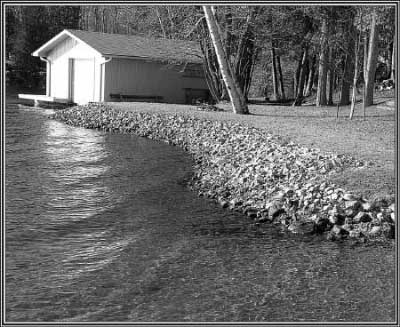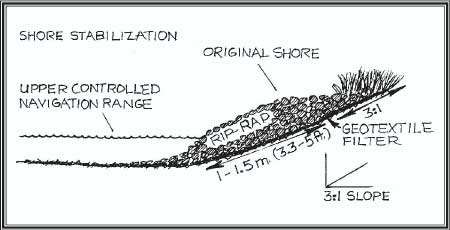page08
[ Previous | Table of Contents | Next ]
7. SHORELINE STABILIZATION
CONTEXT
Shoreline stabilization refers to a variety of works designed to prevent or reduce erosion. These works include the preferred methods of bio-engineering or rip-rap, or a variety of vertical shore walls which are usually composed of armour stone, masonry rock, concrete, steel, wood, plastic, or gabion baskets.
While vertical shore walls have short-term benefits, the retention of existing emergent aquatic vegetation and planting of additional trees and shrubs on the shoreline bank (bio-engineering) is the preferred and most effective method of arresting and preventing further erosion in an environmentally responsible manner. Rip-rap, which is the placement of clean angular stone or rock rubble on a slope, may be used in combination with, or where bio-engineering methods alone would not be effective. Properly sized rip-rap placed along a waterfront over a geo-textile filter fabric is quite effective in dissipating wave action, and preventing soil particles from washing out while allowing land-based moisture to naturally percolate back into the water body.
The most damaging impacts of vertical shore walls as opposed to other methods of shoreline stabilization are:
- Transformation and hardening of the shore;

© Parks Canada - Encroachment onto the bed of the Canal or Waterway;
- Alteration of the overall heritage character of the Canal or Waterway;
- Disturbance/destruction of cultural resources;
- Alteration, disruption or destruction (loss) of fish habitat;
- Altered wave energy and current patterns;
- Sediment transport, turbulence and scouring of the bottom;
- Disruption of the life cycle of aquatic organisms, such as blocking access by amphibians and reptiles back and forth between water and land;
- Short or long-term loss of native waterfront vegetation that plays an important role in preventing erosion and sheet runoff into the waterbody;
- Poorly constructed walls are far more prone to damage due to frost-heaving, erosion when inundated by water or pounded by waves, and destruction by ice movement.
Parks Canada routinely approves environmentally sensitive shoreline stabilization measures.
POLICIES
- The retention of native shoreline vegetation, bio-engineering and rip-rap are, in order, the preferred methods for shoreline stabilization.
- Rip-rap is normally approved for shoreline stabilization subject to the following:
- The material used is clean imported angular stone or rock between 10 and 45 cm (4 - 18 in) in size;
- A geotextile filter fabric is to be installed under and behind the rock;
- A 3:1 (horizontal : vertical) slope ratio is recommended and may not be steeper than 2:1 unless justifiably proposed in an accredited geo-technical report;
- Excavation to create the slope shall be upland; excavation or dredging of the bed is not normally permitted;
- Natural stone must be imported and not removed from the lake or river bed for shoreline stabilization.
- Encroachment of rip-rap shoreline stabilization onto the lake or river bed of up to 1 m (3 ft.) for shrubs and 1.5 m (5 ft.) for trees may be permitted if it can be demonstrated that:
- The encroachment is required to protect significant trees, shrubs and other natural vegetation threatened by erosion;
- The encroachment onto the bed will not harmfully affect fish or fish spawning sites;
- The shore stabilization work would result in the removal of significant natural shoreline vegetation;
- In exceptional circumstances an encroachment beyond 1.5 m (5 ft.) may be allowed if is supported by a geotechnical study.
- Other methods of shore stabilization may be considered if:
- Bio-engineering or rip-rap have been considered and found to be unacceptable due to site conditions;
- The work will be constructed upland of the high water mark and no encroachment onto the bed of the waterbody will occur;
- The work will not alter the existing shoreline contours;
- The work will not result in the removal of natural shoreline vegetation;
- The work will not have a significant impact on the heritage character of the national historic site;
- The shore wall will not result in the harmful alteration, disruption or destruction of fish habitat or other wildlife habitat;
- The backfill will be clean imported material;
- Filter cloth will be installed behind the work to prevent the migration of fines into the water;
- Clean imported rip-rap or rock rubble, of a size approved by the Canal or Waterway and free of silts and organic debris, will be placed along the toe of the work to prevent scour and create aquatic habitat;
- The construction of these works has been approved by the appropriate agency with jurisdiction over waterfront development.
To rectify unique or unusually unstable slope issues, a geotechnical report will be required which may supercede the above slope stabilization policies

© Parks Canada
[ Previous | Table of Contents | Next ]
Related links
- Date modified :

